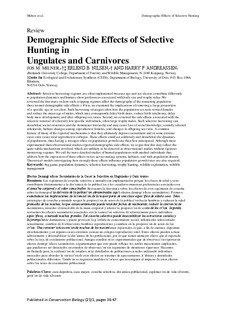| dc.contributor.author | Milner, Jos M. | |
| dc.contributor.author | Nilsen, Erlend Birkeland | |
| dc.contributor.author | Andreassen, Harry Peter | |
| dc.date.accessioned | 2009-12-15T13:07:46Z | |
| dc.date.issued | 2007 | |
| dc.identifier.citation | Milner, J., Nilsen, E., Andreassen, H. (2007) Demographic side effects of selective hunting in ungulates and carnivores. Conservation Biology, 21(1), 36-47 | |
| dc.identifier.other | doi: 10.1111/j.1523-1739.2006.00591.x | |
| dc.identifier.uri | http://hdl.handle.net/11250/134170 | |
| dc.description.abstract | Selective harvesting regimes are often implemented because age and sex classes contribute differently
to population dynamics and hunters show preferences associated with body size and trophy value. We
reviewed the literature on how such cropping regimes affect the demography of the remaining population
(here termed demographic side effects ). First, we examined the implications of removing a large proportion
of a specific age or sex class. Such harvesting strategies often bias the population sex ratio toward females
and reduce the mean age of males, which may consequently delay birth dates, reduce birth synchrony, delay
body mass development, and alter offspring sex ratios. Second, we reviewed the side effects associated with the
selective removal of relatively few specific individuals, often large trophy males. Such selective harvesting can
destabilize social structures and the dominance hierarchy and may cause loss of social knowledge, sexually selected
infanticide, habitat changes among reproductive females, and changes in offspring sex ratio. A common
feature of many of the reported mechanisms is that they ultimately depress recruitment and in some extreme
cases even cause total reproductive collapse. These effects could act additively and destabilize the dynamics
of populations, thus having a stronger effect on population growth rate than first anticipated. Although more
experimental than observational studies reported demographic side effects, we argue that this may reflect the
quite subtle mechanisms involved, which are unlikely to be detected in observational studies without rigorous
monitoring regimes. We call for more detailed studies of hunted populations with marked individuals that
address how the expression of these effects varies across mating systems, habitats, and with population density.
Theoretical models investigating how strongly these effects influence population growth rates are also required. | en |
| dc.format.extent | 600926 bytes | |
| dc.format.mimetype | application/pdf | |
| dc.language.iso | eng | en |
| dc.publisher | Blackwell | en |
| dc.subject | hovdyr | en |
| dc.subject | jakt | en |
| dc.subject | kjøttetere | en |
| dc.subject | selektiv jakt | en |
| dc.subject | storvilt | en |
| dc.subject | populasjonsdynamikk | en |
| dc.subject | troféjakt | en |
| dc.title | Demographic side effects of selective hunting in ungulates and carnivores | en |
| dc.type | Peer reviewed | en |
| dc.type | Journal article | |
| dc.subject.nsi | VDP::Mathematics and natural science: 400::Zoology and botany: 480::Zoogeography: 486 | en |
| dc.source.pagenumber | 36-47 | en |
| dc.source.volume | 21 | en |
| dc.source.journal | Conservation Biology | en |
| dc.source.issue | 1 | en |
